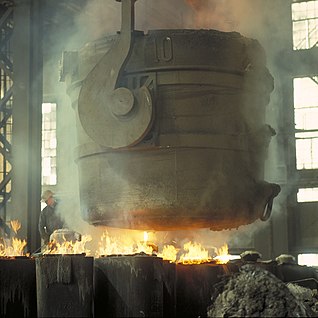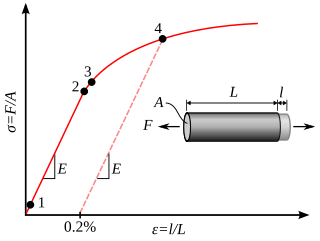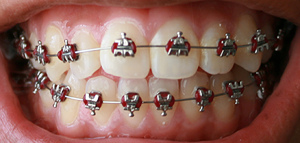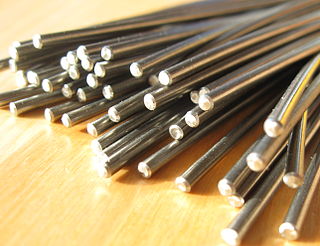Related Research Articles

Zirconium dioxide, sometimes known as zirconia, is a white crystalline oxide of zirconium. Its most naturally occurring form, with a monoclinic crystalline structure, is the mineral baddeleyite. A dopant stabilized cubic structured zirconia, cubic zirconia, is synthesized in various colours for use as a gemstone and a diamond simulant.

Martensite is a very hard form of steel crystalline structure. It is named after German metallurgist Adolf Martens. By analogy the term can also refer to any crystal structure that is formed by diffusionless transformation.

In physics and materials science, plasticity, also known as plastic deformation, is the ability of a solid material to undergo permanent deformation, a non-reversible change of shape in response to applied forces. For example, a solid piece of metal being bent or pounded into a new shape displays plasticity as permanent changes occur within the material itself. In engineering, the transition from elastic behavior to plastic behavior is known as yielding.

Bainite is a plate-like microstructure that forms in steels at temperatures of 125–550 °C. First described by E. S. Davenport and Edgar Bain, it is one of the products that may form when austenite is cooled past a temperature where it is no longer thermodynamically stable with respect to ferrite, cementite, or ferrite and cementite. Davenport and Bain originally described the microstructure as being similar in appearance to tempered martensite.
A shape-memory alloy(SMA) is an alloy that can be deformed when cold but returns to its pre-deformed ("remembered") shape when heated. It may also be called memory metal, memory alloy, smart metal, smart alloy, or muscle wire.
Magnetic shape memory alloys (MSMAs), also called ferromagnetic shape memory alloys (FSMA), are particular shape memory alloys which produce forces and deformations in response to a magnetic field. The thermal shape memory effect has been obtained in these materials, too.

In materials science, a dislocation or Taylor's dislocation is a linear crystallographic defect or irregularity within a crystal structure that contains an abrupt change in the arrangement of atoms. The movement of dislocations allow atoms to slide over each other at low stress levels and is known as glide or slip. The crystalline order is restored on either side of a glide dislocation but the atoms on one side have moved by one position. The crystalline order is not fully restored with a partial dislocation. A dislocation defines the boundary between slipped and unslipped regions of material and as a result, must either form a complete loop, intersect other dislocations or defects, or extend to the edges of the crystal. A dislocation can be characterised by the distance and direction of movement it causes to atoms which is defined by the Burgers vector. Plastic deformation of a material occurs by the creation and movement of many dislocations. The number and arrangement of dislocations influences many of the properties of materials.
Smart materials, also called intelligent or responsive materials, are designed materials that have one or more properties that can be significantly changed in a controlled fashion by external stimuli, such as stress, moisture, electric or magnetic fields, light, temperature, pH, or chemical compounds. Smart materials are the basis of many applications, including sensors and actuators, or artificial muscles, particularly as electroactive polymers (EAPs).

Work hardening, also known as strain hardening, is the strengthening of a metal or polymer by plastic deformation. Work hardening may be desirable, undesirable, or inconsequential, depending on the context.

Crystal twinning occurs when two or more adjacent crystals of the same mineral are oriented so that they share some of the same crystal lattice points in a symmetrical manner. The result is an intergrowth of two separate crystals that are tightly bonded to each other. The surface along which the lattice points are shared in twinned crystals is called a composition surface or twin plane.
Hardening is a metallurgical metalworking process used to increase the hardness of a metal. The hardness of a metal is directly proportional to the uniaxial yield stress at the location of the imposed strain. A harder metal will have a higher resistance to plastic deformation than a less hard metal.

An archwire in orthodontics is a wire conforming to the alveolar or dental arch that can be used with dental braces as a source of force in correcting irregularities in the position of the teeth. An archwire can also be used to maintain existing dental positions; in this case it has a retentive purpose.

Recrystallization is a process by which deformed grains are replaced by a new set of defect-free grains that nucleate and grow until the original grains have been entirely consumed. Recrystallization is usually accompanied by a reduction in the strength and hardness of a material and a simultaneous increase in the ductility. Thus, the process may be introduced as a deliberate step in metals processing or may be an undesirable byproduct of another processing step. The most important industrial uses are softening of metals previously hardened or rendered brittle by cold work, and control of the grain structure in the final product.
In metallurgy, materials science and structural geology, subgrain rotation recrystallization is recognized as an important mechanism for dynamic recrystallisation. It involves the rotation of initially low-angle sub-grain boundaries until the mismatch between the crystal lattices across the boundary is sufficient for them to be regarded as grain boundaries. This mechanism has been recognized in many minerals and in metals.

Nickel titanium, also known as Nitinol, is a metal alloy of nickel and titanium, where the two elements are present in roughly equal atomic percentages. Different alloys are named according to the weight percentage of nickel; e.g., Nitinol 55 and Nitinol 60. It exhibits the shape memory effect and superelasticity at different temperatures.
Ferroelasticity is a phenomenon in which a material may exhibit a spontaneous strain. Usually, a crystal has two or more stable orientational states in the absence of mechanical stress or electric field, i.e. remanent states, and can be reproducibly switched between states by the application of mechanical stress. In ferroics, ferroelasticity is the mechanical equivalent of ferroelectricity and ferromagnetism. When stress is applied to a ferroelastic material, a phase change will occur in the material from one phase to an equally stable phase, either of different crystal structure, or of different orientation. This stress-induced phase change results in a spontaneous strain in the material.
TRIP steel are a class of high-strength steel alloys typically used in naval and marine applications and in the automotive industry. TRIP stands for "Transformation induced plasticity," which implies a phase transformation in the material, typically when a stress is applied. These alloys are known to possess an outstanding combination of strength and ductility.
The R-phase is a phase found in nitinol, a shape-memory alloy. It is a martensitic phase in nature, but is not the martensite that is responsible for the shape memory and superelastic effect.
In materials science, the yield strength anomaly refers to materials wherein the yield strength increases with temperature. For the majority of materials, the yield strength decreases with increasing temperature. In metals, this decrease in yield strength is due to the thermal activation of dislocation motion, resulting in easier plastic deformation at higher temperatures.
Toughening is the improvement of the fracture resistance of a given material. The material's toughness is described by irreversible work accompanying crack propagation. Designing against this crack propagation leads to toughening the material.
References
- ↑ Bhadeshia, H. K. D. H. "The Bain Correspondence" (PDF). Materials Science and Metallurgy. University of Cambridge.
- ↑ Thorsten Krenke; et al. (2007). "Magnetic superelasticity and inverse magnetocaloric effect in Ni-Mn-In". Physical Review B. 75 (10): 104414. arXiv: 0704.1243 . doi:10.1103/PhysRevB.75.104414.
- ↑ J. San Juan; et al. (2014). "Long-term superelastic cycling at nano-scale in Cu-Al-Ni shape memory alloy micropillars". Applied Physics Letters. AIP. 104: 011901. doi:10.1063/1.4860951.
- ↑ J. San Juan; et al. (2013). "superelasticity and shape memory at nano-scale: size effects on the martensitic transformation". Journal of Alloys and Compounds. Elsevier. 577: S25–S29. doi:10.1016/j.jallcom.2011.10.110.
- ↑ Ning Zhang; et al. (2016). "Competing mechanisms between dislocation and phase transformation in plastic deformation of single crystalline yttria-stabilized tetragonal zirconia nanopillars". Acta Materialia. 120: 337–347. arXiv: 1607.03141 . doi:10.1016/j.actamat.2016.08.075.
- Liang C., Rogers C. A. (1990). "One-Dimensional Thermomechanical Constitutive Relations for Shape Memory Materials". Journal of Intelligent Material Systems and Structures. 1 (2): 207–234. doi:10.1177/1045389x9000100205.
- Miyazaki S, Otsuka K, Suzuki Y (1981). "Transformation Pseudoelasticity and Deformation Behavior in a Ti-50.6at%Ni Alloy". Scripta Metallurgica. 15 (3): 287–292. doi:10.1016/0036-9748(81)90346-x.
- Huo, Y.; Müller, I. (1993). "Nonequilibrium thermodynamics of pseudoelasticity". Continuum Mechanics and Thermodynamics. Springer Science and Business Media LLC. 5 (3): 163–204. doi:10.1007/bf01126524. ISSN 0935-1175.
- Tanaka K., Kobayashi S., Sato Y. (1986). "Thermomechanics of transformation pseudoelasticity and shape memory effect in alloys". International Journal of Plasticity. 2 (1): 59–72. doi:10.1016/0749-6419(86)90016-1.
{{cite journal}}: CS1 maint: multiple names: authors list (link) - Kamita, Toru; Matsuzaki, Yuji (1998-08-01). "One-dimensional pseudoelastic theory of shape memory alloys". Smart Materials and Structures. IOP Publishing. 7 (4): 489–495. doi:10.1088/0964-1726/7/4/008. ISSN 0964-1726.
- Yamada, Y. (1992-09-01). "Theory of pseudoelasticity and the shape-memory effect". Physical Review B. American Physical Society (APS). 46 (10): 5906–5911. doi:10.1103/physrevb.46.5906. ISSN 0163-1829.